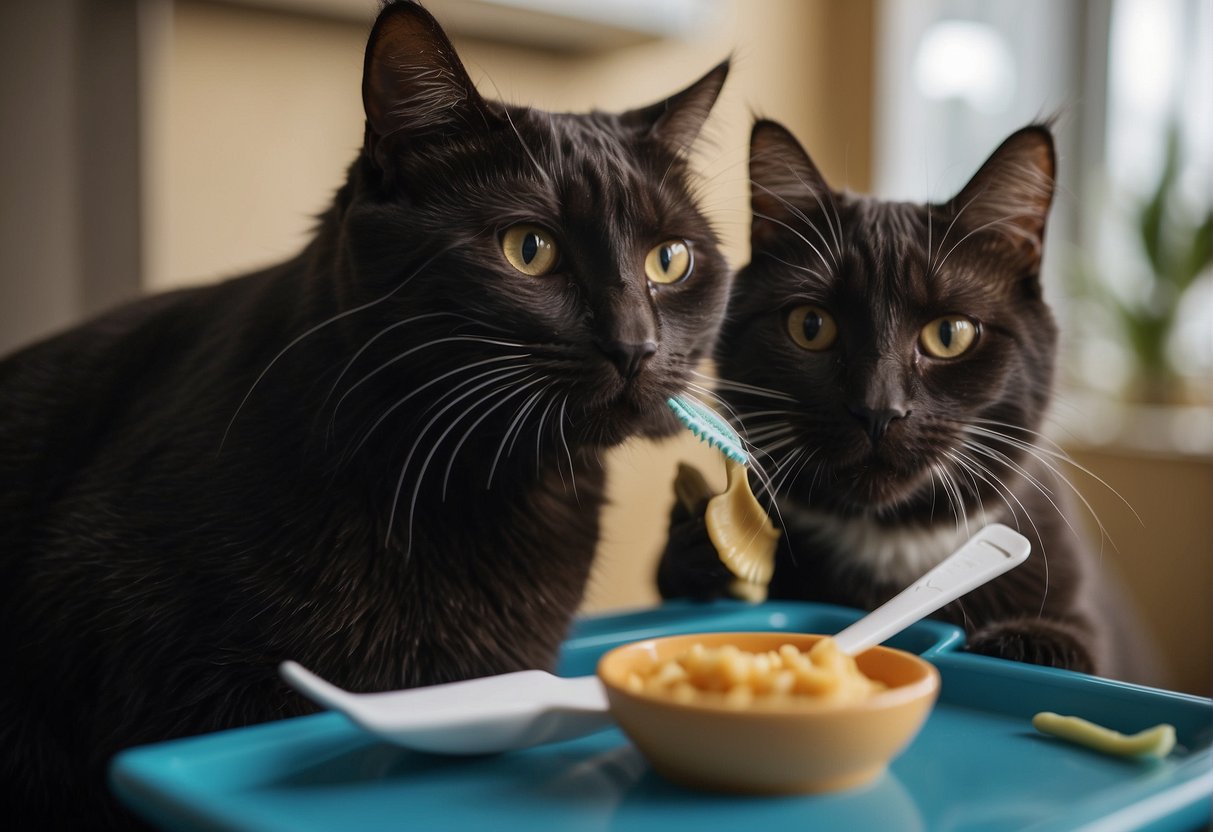Caring for a toothless cat involves some unique considerations to ensure your beloved feline maintains good health and happiness. It’s not uncommon for cats, especially as they age, to experience tooth loss due to various reasons such as feline odontoclastic resorptive lesions, injuries, or even dental procedures necessary for their wellbeing.
It’s important to understand that while your cat may have no teeth, they can still lead a comfortable and fulfilling life with the proper care.

Adjusting your cat’s diet is often the first step to accommodate their toothless condition. Soft, canned food or a well-moistened kibble can make eating not only possible but pleasurable for them again.
Some cats might even surprise you with their ability to ‘gum’ their food or use their tongue to manipulate it, showcasing the remarkable adaptability of our feline friends. Throughout their transition to a toothless diet, it’s critical to monitor their eating habits and weight to ensure they’re receiving adequate nutrition.
Beyond dietary changes, regular veterinary check-ups are vital to monitor for any complications arising from tooth loss, such as issues with the gums or changes in oral hygiene. While caring for a toothless cat might seem daunting at first, with your attention and adjustments, your cat will continue to thrive.
Dental Care for a Toothless Cat

Ensuring your toothless feline friend maintains good oral health is paramount. Just because your cat has no teeth doesn’t mean their mouth care should be overlooked.
Regular Oral Hygiene Practices for Cats Without Teeth
Toothless cats can still develop dental diseases such as gingivitis, stomatitis, and periodontal disease. Even without teeth, the gums can harbor bacteria, leading to plaque buildup and infections.
Tooth resorption might have been the reason your cat lost their teeth, so it’s important to maintain their oral health to prevent discomfort and potentially serious complications.
- Daily Gum Cleaning: Use a soft, wet cloth or gauze to gently wipe your cat’s gums every day. This removes food particles and reduces the risk of plaque buildup.
- Oral Rinses: There are special antiseptic oral rinses formulated for cats that can help maintain a healthy mouth. Always use products recommended by your vet.
- Routine Checkups: Regular veterinary checkups are crucial. Your vet can spot early signs of oral issues and advise you on specific care for your cat’s situation.
- Recognizing Symptoms: Be vigilant and watch for signs of oral discomfort. Bad breath, drooling, or reluctance to eat might indicate an underlying problem.
Feeding Strategies for Cats with No Teeth
Caring for a toothless cat requires understanding their eating habits and providing a diet that is easy for them to consume and nutritious for their overall health.
Choosing the Right Food for a Toothless Cat
When it comes to feeding a cat with no teeth, wet food typically makes for the easiest eating experience. It’s soft enough for your furry friend to lap up without the need for chewing. If your cat tends to prefer dry food, you can soften it with water or broth to make it more manageable. This can be especially useful if they’re used to the texture and taste of their usual kibble.
In addition to these options, freeze-dried food can be rehydrated and may be a suitable choice. It’s important to ensure that all food is at a soft, mushy consistency that can be easily ingested without chewing.
Look for foods that are high in omega fatty acids to support overall health and coat condition, especially if your cat struggles with dental issues.
Cats with no teeth eat by scooping their food with their tongue and swallowing it whole, so finding food that doesn’t require significant prehension or grinding is key. Here are some specifics:
- Wet Food: Choose pâté or mousse textures that are smoother and easier to scoop.
- Dry Food: If your cat prefers dry food, opt for high-quality kibble and soften it with warm water or a vet-approved broth.
- Freeze-Dried Food: Make sure to thoroughly soften freeze-dried morsels to a pâté-like consistency.
Pain Management for Cats After Tooth Loss
Managing your cat’s pain after tooth loss is crucial for their comfort and recovery. Here you’ll learn specific measures to alleviate dental pain and ensure your feline friend’s well-being during this sensitive time.
Comfort Measures for Cats with Dental Pain
After your cat has had teeth extracted or if they’re experiencing dental trauma, such as gingivostomatitis, it’s important to mitigate discomfort effectively. Here’s how you can help:
- Soft Food: Post-extraction, a soft food diet is easier to eat and gentle on the gums. Offer canned food or kibble soaked in warm water.
- Medication: Your veterinarian may prescribe pain relief medication appropriate for your cat’s condition. Administer these medications exactly as directed.
- Quiet Space: Provide a quiet, cozy area for your cat to rest away from noise and other pets, reducing stress which can heighten the perception of pain.
- Gentle Affection: Soft pets and calm, soothing attention can comfort your cat, but be mindful not to touch the area near the mouth that could be sore.
Preventing Gum Disease in Cats Without Teeth
Even without teeth, your cat’s oral health is crucial. Healthy gums are vital for your cat’s overall well-being, and there are specific steps you can take to maintain them.
Keeping Toothless Cats’ Gums Healthy
Toothless cats are still at risk for oral health issues such as gingivostomatitis and periodontal disease. Here are targeted strategies to keep your cat’s gums in great shape:
- Routine Check-Ups: Regular visits to a veterinary dentist are key. They can spot early signs of gum disease or conditions like stomatitis, which can be painful for your furry friend.
- Soft Diet: Provide a soft diet that’s easy on the gums. This can prevent irritation and help avoid conditions such as feline odontoclastic resorptive lesions (FORL), which can still affect cats without teeth.
- Oral Hygiene: Maintain a routine that includes gently wiping the gums with a soft, damp cloth to remove food particles and bacteria. It’s a toothbrush-free way to keep the mouth clean.
- Professional Cleanings: Just like us, cats benefit from professional dental cleanings. These should be performed by your vet or a pet dental specialist, especially since toothless cats can accumulate plaque on their gums.
- Look for Signs: Keep an eye out for redness, swelling, or any signs that eating is painful for your cat. This could indicate gum disease or other oral health issues that need immediate attention.

My name is James, and welcome to FAQCats!
Along with our team of cat owners, expert pet enthusiasts, and pet professionals, we aim to write engaging helpful, engaging content about cats. At FAQCats we strive to provide content that’s accurate and fun to read. Our team writes about everything related to cats; even the most complex of topics. Through extensive research and caring for our own fur-pals, we’re able to provide something cat owners worldwide will love. Have a look around, and leave us feedback anytime!

